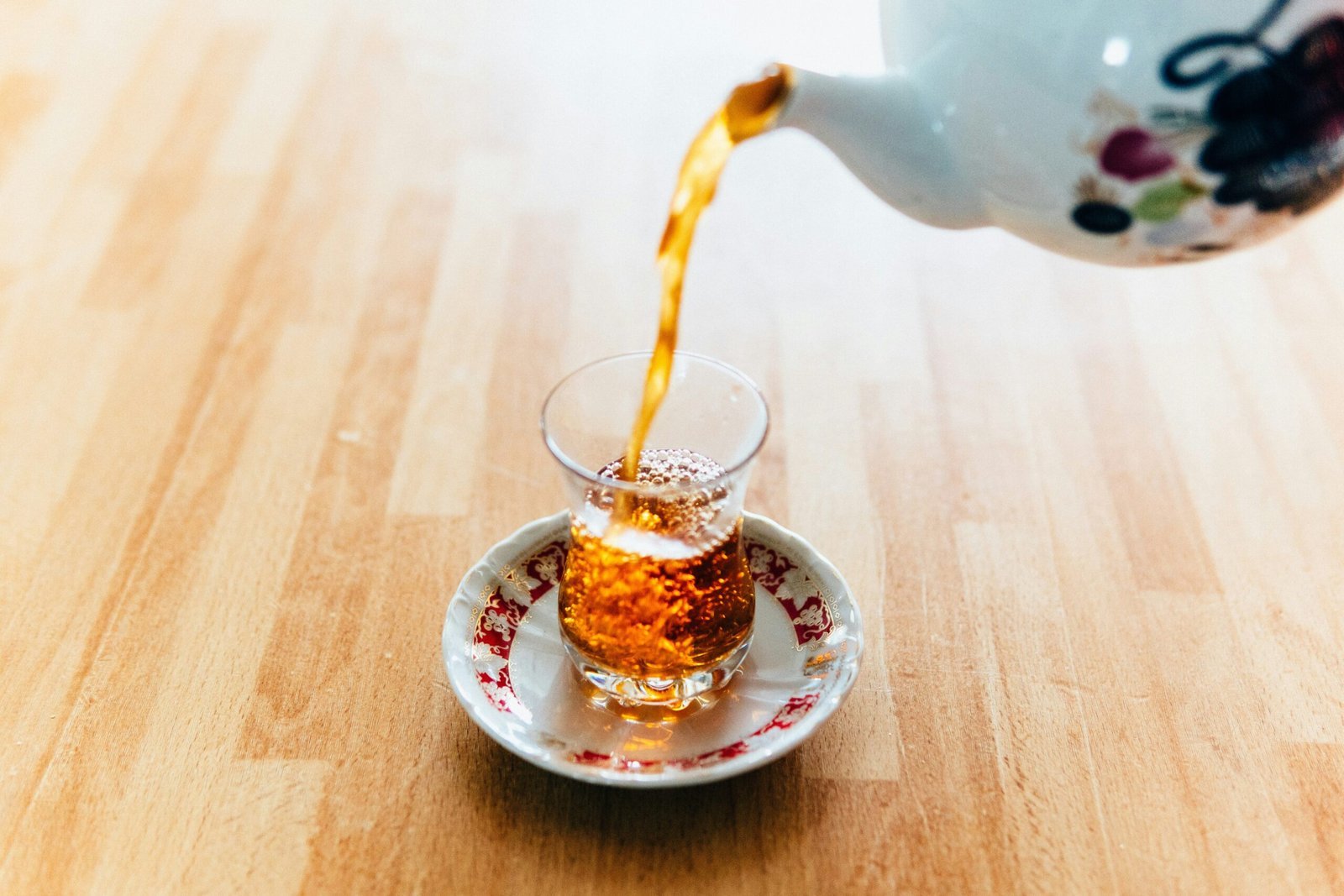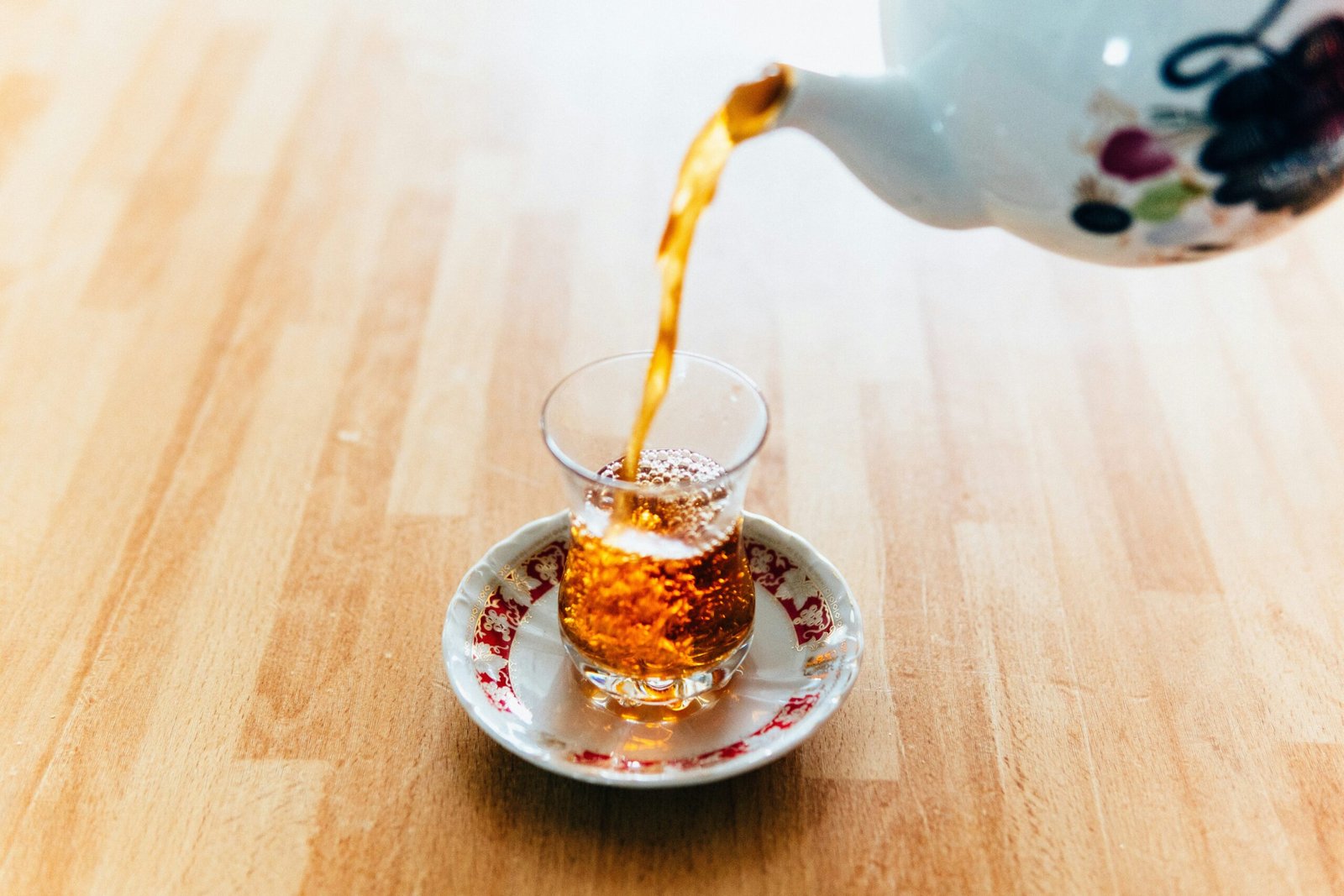
Introduction to Iranian Tea Culture
Tea holds a venerable place in Iranian culture, deeply woven into the fabric of daily life and traditions. Originating from China, tea was introduced to Persia in the 16th century and quickly evolved from a luxury item to a vital component of communal living. Names such as “chai” or “dari” reflect its profound cultural significance, demonstrating how this beverage has transcended mere consumption to become a symbol of hospitality and social interaction.
Throughout history, tea has functioned as a bridge among generations, fostering connections and communication across diverse societal groups. In traditional settings, it is common for families and friends to gather over a pot of steaming tea, engaging in conversations that can last for hours. This practice illustrates the Iranian belief that tea is more than just a drink; it is an essential element in nurturing relationships and creating bonds.
The tea houses, or “chai khaneh,” have catapulted this cultural phenomenon into a social institution. Historically, these establishments served as hubs for artistic expression, intellectual discourse, and community engagement. Today, they continue to play a significant role in urban areas, offering patrons a place to unwind and engage in leisurely conversations or enjoy games such as backgammon. These tea houses vary in ambiance, from lavishly decorated establishments featuring ornate tile work to modest corners that exude an air of simplicity.
Moreover, the process of brewing and serving tea in Iran is an art form in itself, emphasizing the careful selection of tea leaves and the intricate rituals surrounding its preparation. This attention to detail enhances the overall tea experience, evoking a sense of appreciation for quality and tradition. Thus, Iranian tea culture encapsulates not just the beverage but a lifestyle characterized by warmth, community, and hospitality that resonates through the ages.
The Origins of Tea in Iran
The journey of tea in Iran dates back to the 16th century, a significant period when the beverage began to weave itself into the fabric of Persian culture. It is widely believed that tea was introduced to Iran through the efforts of Shah Abbas I, who was fascinated by the drink and its popularity in neighboring countries. Initially, tea was met with skepticism by the Iranian populace, as it was somewhat foreign to their established beverage preferences, primarily dominated by coffee and herbal infusions. However, the distinctive flavor and invigorating properties of tea soon captured the attention of many, leading to its widespread acceptance.
Tea drinking became a fashionable activity among the elites of Persian society, and its popularity surged during the Safavid dynasty. Historical accounts suggest that tea was initially consumed in exclusive settings, often referred to as “tea houses.” These venues began to proliferate, becoming social hubs where men gathered to discuss politics, literature, and philosophy over a cup of tea. The cultural acceptance of tea flourished alongside the establishment of tea plantations in northern Iran, particularly in the Gilan and Mazandaran provinces, where the climate and soil conditions proved to be ideal for tea cultivation.
Over time, the production of Iranian tea evolved into an important economic sector. Key historical figures, including merchants and agricultural innovators, contributed to the development of tea cultivation practices, which further entrenched its place in Iranian life. By the 19th century, tea had transitioned from a luxury item for the elite to an everyday staple enjoyed by people from all walks of life. The infusion of tea into Iranian culture is not merely about the beverage itself; it reflects significant aspects of social interaction, hospitality, and the rich tapestry of Persian traditions that continue to thrive to this day.
The Architecture and Ambiance of Tea Houses
The architecture of traditional Iranian tea houses, often referred to as “chayi khaneh,” is characterized by a distinctive blend of local styles and cultural influences that reflect Iran’s rich historical tapestry. These establishments are typically designed to create a welcoming environment, providing patrons with an escape from the hustle and bustle of daily life. The most common architectural features include arched doorways, intricately tiled façades, and courtyards adorned with lush greenery, creating a serene atmosphere conducive to relaxation.
Inside, the ambiance is equally captivating. Soft, diffused lighting, often from hanging lanterns or lamps, complements the colorful carpets and cushions scattered throughout the seating areas. The seating arrangements are traditionally low, using cushions and carpets to encourage a relaxed posture, promoting comfort and intimacy amongst visitors. The walls are frequently embellished with decorative elements, such as paintings or calligraphy, which celebrate Persian culture and heritage, enhancing the overall aesthetic appeal of the tea house.
Moreover, the cultural significance of tea houses in Iran extends beyond mere architecture; they serve as community hubs where people gather to socialize, share stories, and enjoy the ritual of tea drinking. The ambiance is often lively yet soothing, fostering an environment where conversations flow easily, bolstered by the warm aroma of blooming tea and spices. Patrons may engage in traditional games, poetry recitals, or simply appreciate the artistry of Persian music playing softly in the background. This multifaceted atmosphere makes each tea house a unique reflection of its locality, imbued with a sense of hospitality that is central to Iranian culture. Ultimately, the architectural elements and ambiance of these establishments contribute significantly to the experience of enjoying authentic Persian tea traditions.
Traditional Tea Brewing Techniques
The art of brewing tea in Iran is steeped in tradition and craftsmanship, reflecting the country’s rich cultural heritage. Central to this process is the samovar, a sophisticated metal container used for heating water and steeping tea. The samovar not only serves as a functional item but also symbolizes hospitality and the social culture surrounding tea drinking in Iran. Tea is often brewed using loose leaf varieties, predominantly black tea, which is favored for its robust flavor. Common types of tea include Ceylon tea and Darjeeling, both of which are lauded for their aromatic qualities.
One traditional brewing method involves placing loose tea leaves in the upper compartment of the samovar, where they are steeped in concentrated hot water. This method allows for the development of a rich and flavorful brew. Once the desired strength is achieved, the brewed tea is usually diluted with hot water from the samovar’s lower compartment to suit individual tastes. This technique underscores the personalized nature of tea drinking among families and friends, where everyone can adjust the strength according to their preference.
In addition to traditional black tea, various blends are commonly prepared, featuring herbs and spices that may enhance both flavor and health benefits. Popular blends often incorporate cardamom, mint, and saffron, which not only provide a delightful fragrance but are also believed to offer health advantages such as boosting digestion and enhancing mood. The distinctiveness of Iranian tea culture lies in these traditional practices, many of which have been passed down through generations. Therefore, brewing tea is not merely a chore but a ritual that embodies the essence of Iranian hospitality, encouraging connection and conversation among those who partake.
Famous Persian Tea Varieties
Persian tea culture is rich and diverse, featuring a variety of beloved tea types that reflect the country’s long history and colorful traditions. One of the most popular varieties is black tea, commonly referred to as “chai.” Black tea holds a significant place in Persian households, often served in small glasses and accompanied by rock candy or sweet pastries. The distinct bold flavor and deep amber hue of Persian black tea make it a refreshing beverage, suitable for both casual gatherings and formal ceremonies.
In addition to black tea, herbal infusions are widely cherished in Iran. One prominent example is “chai nan,” which is flavored with spices like cinnamon, cardamom, and rose petals. These herbal blends not only provide a unique taste experience but also offer numerous health benefits, aligning with the traditional Persian value of herbal remedies. The aroma of such infusions often fills the air, creating a soothing atmosphere that enhances social interactions.
Specialty blends, such as “chai zabzadeh,” which includes brewed tea with hints of dried fruit and nuts, reflect the creativity of Persian tea culture. This particular blend signifies hospitality, often served to guests as a gesture of warmth and welcome. Each sip of these specialty teas provides a glimpse into Iranian artistry and social customs, showcasing the importance of tea in daily life and celebrations alike.
Furthermore, particular settings play a crucial role in how Persian teas are enjoyed. Whether it’s in a cozy tea house, during family gatherings, or at festive occasions, each setting influences the enjoyment of the tea. The unique flavors and aromas of these various tea types not only cater to personal preferences but also underscore the cultural significance of tea within Iranian society. Overall, each variety contributes to the rich tapestry of Iran’s tea house culture.
Tea House Etiquette and Social Customs
Visiting a tea house in Iran is an experience deeply rooted in the nation’s rich cultural heritage. The accompanying etiquette and customs contribute significantly to the social fabric of these establishments. Upon entering a tea house, patrons often greet one another with a friendly nod and a warm smile, reflecting hospitality and respect. This initial exchange sets the tone for the social interactions that follow and is an integral part of Persian etiquette.
Sharing tea in Iran is more than just a daily ritual; it embodies the spirit of generosity and camaraderie. It is customary for tea to be served alongside sweets or savory snacks, creating an inviting atmosphere for conversation. When guests share a pot of tea, it symbolizes trust and the fostering of relationships. As such, it is common for patrons to engage in light-hearted discussions and to offer their guests the first pour, reinforcing the significance of mutual respect.
The essence of conversation and storytelling is paramount in these communal spaces. Tea houses serve as intimate venues where individuals can share personal anecdotes, cultural narratives, and philosophical musings. The act of storytelling invokes a sense of connection among participants, be it amongst friends, family, or even strangers. This exchange is not merely for entertainment; it nurtures a culture of learning and collective wisdom within the community.
Furthermore, the role of tea houses extends beyond a mere commercial venue. They emerge as crucial social hubs where community ties are strengthened and relationships are nurtured. In many respects, these establishments are timeless sanctuaries where the warmth of hospitality and the cultural essence of Iran converge, making the experience of visiting a tea house truly unique. By understanding and embracing the etiquette and social customs in these settings, visitors can fully appreciate and immerse themselves in the authentic Persian tea traditions.
The Role of Sweets and Snacks in Tea Culture
In Iran, the tea-drinking experience is often complemented by a variety of traditional sweets and snacks, which enhance not only the flavor profile but also the overall cultural significance of the ritual. Among these delicacies, baklava stands out as a popular choice. This sweet pastry, made of layers of filo dough filled with chopped nuts and sweetened with honey or syrup, offers a delightful contrast to the warm, robust flavor of Persian tea. Baklava is typically served in small pieces, allowing guests to indulge without overwhelming their palate.
Another notable accompaniment is saffron cake, which showcases the unique aroma and taste of Persian saffron. Renowned for its vibrant color and rich flavor, saffron elevates the cake, making it an exquisite pairing with tea. The cake’s soft texture and sweet undertones complement the aromatic qualities of the tea, creating a harmonious balance that is celebrated in Iranian hospitality.
Additionally, various types of nuts, such as pistachios, almonds, and walnuts, are frequently offered alongside tea. These nuts not only provide a satisfying crunch but also contribute a range of flavors that enhance the experience. Iranians often serve nuts as a sign of hospitality, signaling warmth and generosity. The ritual of enjoying tea with sweets and snacks plays a crucial role in fostering connections among family and friends, creating an inviting atmosphere where conversations flow freely.
Overall, the integration of sweets and snacks into Iran’s tea culture cannot be overstated. These accompaniments transform a simple beverage into a celebratory experience, enriching social interactions and reflecting the country’s rich culinary traditions. By savoring the flavors of baklava, saffron cakes, and a selection of nuts, one can truly appreciate the art of Persian tea drinking, where every element plays a significant role in the ritual of hospitality.
Modern Tea Houses: Blending Tradition and Innovation
The evolution of tea houses in contemporary Iran showcases a fascinating blend of traditional practices and innovative trends, reflecting changing societal tastes and lifestyles. While classic tea houses have long been a staple of Iranian culture, modern establishments are redefining the experience by incorporating contemporary designs, diverse offerings, and unique customer experiences.
Today, many new tea houses feature minimalist designs that contrast with the ornate interiors of their traditional counterparts. These modern spaces often utilize contemporary furnishings and soothing color palettes, creating an inviting atmosphere that attracts a younger clientele. This shift in design not only enhances the visual appeal but also fosters an environment conducive to socializing and relaxation.
Moreover, the offerings in these modern tea houses are expanding beyond the traditional Persian tea. Patrons can now find an array of beverages that fuse local flavors with international influences. Specialty teas infused with herbs, spices, and fruits have become increasingly popular, while unique blends such as saffron-infused or rosewater-infused teas are enticing the adventurous palate. Furthermore, a range of pastries and desserts, both traditional and modern, complement the tea experience, providing a well-rounded culinary journey.
In addition to traditional tea services, themed tea experiences are gaining traction. Some tea houses are crafting immersive events that celebrate Iranian culture through music, art, or storytelling. These innovative experiences allow customers to savor their tea while engaging with various aspects of Persian heritage, creating lasting memories and a deeper connection to the culture.
As the popularity of modern tea houses continues to rise, it is evident that they are not only preserving the essence of Iranian tea culture but also propelling it into the future. By embracing innovation while respecting tradition, these establishments are redefining how tea is enjoyed in Iran. This dynamic interplay of old and new ensures that the rich history of Persian tea will persist, evolving to meet the desires of a modern audience.
Experiencing Authentic Persian Tea Traditions
To fully immerse oneself in the rich tapestry of Iran’s tea house culture, a visit to a traditional tea house is essential. These establishments serve as social hubs, where friends and families gather to indulge in the time-honored ritual of drinking tea. While traveling through Iran, you will find that tea houses are spread throughout cities and towns, from bustling bazaars to quiet neighborhoods. Look for tea houses that have been family-run for generations, as they often provide the most authentic experience.
When you enter a tea house, you will be greeted with a warm welcome—often accompanied by the fragrant aroma of freshly brewed tea. To order, approach the counter and select your preferred type of tea, which ranges from the classic black tea served in small glasses to various herbal infusions. Keep in mind that different regions in Iran offer unique tea blends, so feel free to ask the staff for recommendations. It is customary to enjoy tea with an assortment of snacks such as pastries, traditional sweets, or a savory plate of pistachios or walnuts, enhancing the overall experience.
During your visit, embrace the leisurely pace of life that tea houses embody. This is not merely a place to consume tea; it is a setting for conversation, reflection, and connection. Expect to see patrons engaged in animated discussions, playing games, or simply enjoying the ambiance. Be sure to respect local customs, such as removing your shoes if the tea house has those guidelines and following any protocols around sharing a table with strangers.
By visiting an authentic tea house, you will not only savor the rich flavors of Persian tea but also gain insight into the importance of this social tradition in Iranian culture. This experience will leave you with treasured memories of the warmth and hospitality that define Iranian tea house culture.

